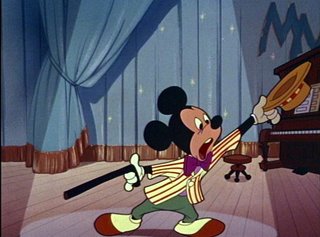CARTOONSKIN


 Real wrinkles are really different than cartoon wrinkles.
Real wrinkles are really different than cartoon wrinkles. Ever wonder why clothes fit so tight on old cartoon characters? Why the wrinkles don't look anything like real wrinkles?
Ever wonder why clothes fit so tight on old cartoon characters? Why the wrinkles don't look anything like real wrinkles?
 That's why wrinkles are kept to a minimum in old cartoons, and why they are generally very tightly wrapped around the forms of the characters. It makes an interesting surface look. It's called "cartoon skin".
That's why wrinkles are kept to a minimum in old cartoons, and why they are generally very tightly wrapped around the forms of the characters. It makes an interesting surface look. It's called "cartoon skin". The wrinkle physics of cartoon skin are applied to all surfaces of classic cartoons: flesh, fur, clothing.
The wrinkle physics of cartoon skin are applied to all surfaces of classic cartoons: flesh, fur, clothing.![[max_hare.jpg]](https://blogger.googleusercontent.com/img/b/R29vZ2xl/AVvXsEg-Fw7iPhIgRLSYrxBBCANbPna7BG22Ii0tTF4WqHsAU3PxBGMYHaKOm7DXrJlkuK1quutXNcR3FtztNweiHxRl5BIUJR-PD_yx0YYxFVP8gHsvYPnCcWv0hVdtvMx8vHcdogB5/s1600/max_hare.jpg)
 Even Rod Scribner who loves wrinkles and draws lots of them, still doesn't draw them remotely realistic. He just does looser floppier cartoon skin and creates a very funny effect.
Even Rod Scribner who loves wrinkles and draws lots of them, still doesn't draw them remotely realistic. He just does looser floppier cartoon skin and creates a very funny effect.ENTER THE AGE OF LUMPYPANTS

When I got started in the business they had abandoned cartoonskin in favor of a new form of equally unrealistic fabric surface - "Lumpypants".

This design approach is meant to be more sophisticated and serious than classic cartoon surfaces but it is doubly ironic:
1) It doesn't remotely look anything like the way wrinkles really look.
2) It's impossible to animate and makes the characters morph and melt all over the screen.
So in effect, it's both ugly and impractical at the same time, which seems to be the 2 general goals of animation ever since the late 60s.
Ugly and impractical equals "quality" in the minds of people who don't like cartoons, because it is so obviously not cartoony or fun.



Disney - when it really was a "quality" animation studio used cartoonskin, even in its more elaborate high-minded features.

When I got started in the business they had abandoned cartoonskin in favor of a new form of equally unrealistic fabric surface - "Lumpypants".

This design approach is meant to be more sophisticated and serious than classic cartoon surfaces but it is doubly ironic:
1) It doesn't remotely look anything like the way wrinkles really look.
2) It's impossible to animate and makes the characters morph and melt all over the screen.
So in effect, it's both ugly and impractical at the same time, which seems to be the 2 general goals of animation ever since the late 60s.
Ugly and impractical equals "quality" in the minds of people who don't like cartoons, because it is so obviously not cartoony or fun.



Disney - when it really was a "quality" animation studio used cartoonskin, even in its more elaborate high-minded features.

It was depressing drawing designless formless blobs in Saturday Morning cartoons in the 80s, but it was even more shocking to lovers of classic cartoons when "Disney" in the late 80s brought Saturday Morning cartoon design and Lumpypants to bigscreen big-budget fully animated productions.
LUMPYPANTS hit the big screen

 There was a time when there was an obvious difference between quality cartoons and Saturday morning cartoons. You could tell instantly by the look of the designs what was a quality cartoon. Once Disney changed over to the Saturday Morning look it changed forever the automatic distinction between good and amateurish and gave tasteless executives even more control over big budget animation.
There was a time when there was an obvious difference between quality cartoons and Saturday morning cartoons. You could tell instantly by the look of the designs what was a quality cartoon. Once Disney changed over to the Saturday Morning look it changed forever the automatic distinction between good and amateurish and gave tasteless executives even more control over big budget animation.In effect we have DIC design fully animated.
 Along with lumpypants came Saturday Morning cartoon storylines, too much exposition and explanation, bland music, Saturday Morning Cartoon colors and just general Saturday Morning Cartoon thinking all around - except with humongous budgets that somehow are supposed to magically turn all the bad creative decisions into quality.
Along with lumpypants came Saturday Morning cartoon storylines, too much exposition and explanation, bland music, Saturday Morning Cartoon colors and just general Saturday Morning Cartoon thinking all around - except with humongous budgets that somehow are supposed to magically turn all the bad creative decisions into quality.The transition: Little Mermaid has a body and fish ass made of cartoon skin, but her hair is made of Ghostbuster Lumpypants.

More on wrinkles in another thrilling article coming soon - comic book wrinkle theory






























































